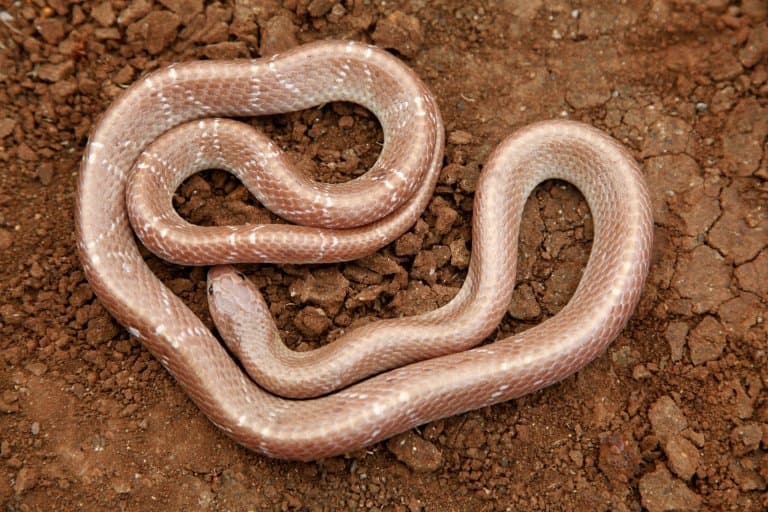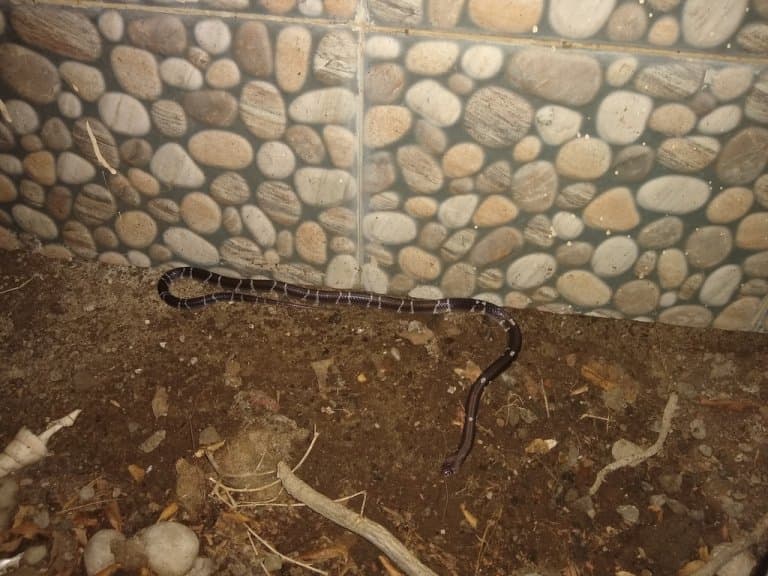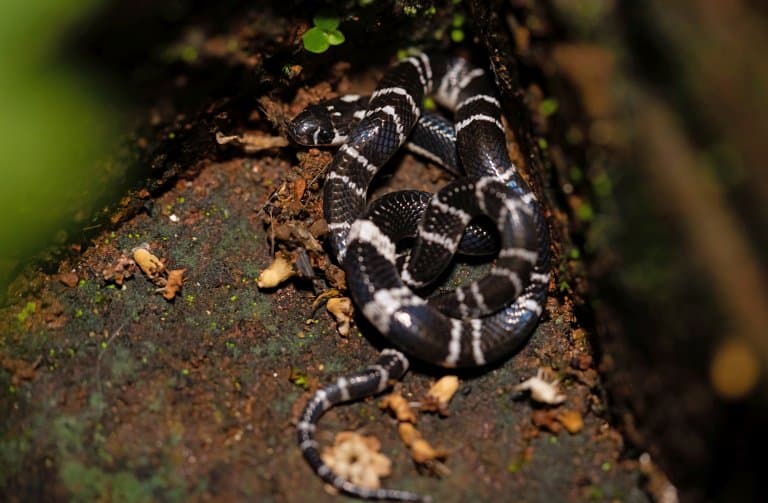Common Krait Profile
People love to justify their irrational fears by overblowing the danger they’re in. Myths about swans breaking arms, or wasps stinging you “for no reason” all stem from the inability of flailing animals to admit they’ve let their monkey brains take over their bodies.
So, tales of the deadliest snakes slipping silently into your bed at night to kill you, immediately sound like the desperate ravings of a secret coward. That is, of course, unless they’re talking about kraits.
The common krait is a highly venonmous elapid snake that’s native to the Indian subcontinent and a member of the ‘big four’ species, that inflict the most snakebites in India, Pakistan and Bangladesh.

Common Krait Facts Overview
| Habitat: | Forests, rocky terrain, grasslands and human habitations |
| Location: | Pakistan, through India, Sri Lanka |
| Lifespan: | Up to 17 years |
| Size: | Up to 1.75m (9ft) long, usually less than 1m |
| Weight: | Around 1.2kg (2.6lb) |
| Colour: | Blue-black with white bars |
| Diet: | Snakes, small mammals, lizards |
| Predators: | Other kraits |
| Top Speed: | Unknown, usually sluggish |
| No. of Species: | 1 |
| Conservation Status: | Least concern |
Common kraits live in a variety of habitats, including fields, low scrublands and the outskirts of villages and farmlands.
They are nocturnal hunters that primarily feed on snakes, but will also eat rats, mice, lizards and frogs. They have a powerful venom that contains neurotoxins, which induce muscle paralysis in prey.
A snake this deadly does of course have some fiction attached to its reputation, but the reality of it is just as scary. This is a killer that sometimes leaves no trace; it’s able to sneak in and out without the victim even waking up.
Yet, deaths do appear to be entirely a result of mistaken identity, and despite the eeriness of the situation, it’s one that seems to be easily fixed.
Sadly, in the regions in which this snake causes the most human deaths, wealth inequality means it’ll be a long time before the people can afford to be safe.
Interesting Common Krait Facts
1. They’re in the Big Four
Kraits are highly venomous snakes in the cobra, or Elapid, family. They’re known by experts to be relatively docile, even sluggish during the day, and can often be handled without trouble by experienced snake ticklers.
Even when active, they flee from trouble rather than heading towards it, and yet these are one of India’s “Big Four”, an apocalyptic quartet responsible for the most deaths of any snakes in the world.
Common kraits are responsible for the fourth-most human deaths from snake bites across the Indian subcontinent, after the Saw-scaled viper, Russell’s viper, and Indian Cobra. They are also responsible for the second-highest number of snake bites in India alone.
They are estimated to be responsible for around 10k deaths each year.

2. They’re snake-eaters
But humans are typically too big for a krait to eat, and this species is much happier munching on smaller prey – primarily, other snakes. Kraits are well known for this, and some species feed almost exclusively on their serpentine brethren.
Common kraits aren’t quite as choosy and will branch out into the mammalian class too, as well as taking on the odd lizard, here and there.
3. Common kraits are cannibals
But, as kraits, they’re also known to be cannibalistic, especially as youngsters. This doesn’t seem to be a particular preference, rather than a lack of concern for which species they’re eating.
But it isn’t food that brings them into conflict with humans. 1

4. They live where people live
Common kraits are widespread and common across their range and can occupy a diverse set of habitats.
They’re as comfortable on remote rocky terrain as they are in the middle of a populated village, and while they spend most of the day resting in termite mounds or beneath debris, they are much more active at night.
They are often keen to stay close to water, too, and this is where people end up coming into contact with them. In fact, a study from Sri Lanka recorded that 100% of krait bites occurred inside houses.
The overlapping habitats between the rapidly increasing human population and the native kraits are one of the key factors that makes them so dangerous. But these snakes are definitely not looking for a fight. 2
5. They’re reluctant to bite
Very few species of snake are truly aggressive. It’s said that the black mamba will chase down a threat, rather than flee from it, but this is by far the exception, rather than the rule, regardless of what the flailing monkey brains will claim.
Particularly when they’re off-duty, common kraits are notoriously tolerant. They can be handled well and will usually roll into a defensive ball and try to ignore the abuse.
They’re known to be slow and dopey during the day and are exclusively nocturnal hunters.
And for night-time activities, they’re well-equipped. The extra-wide forked tongue gives the snake a sense of smell in stereo and helps them sniff out their prey without light.
Humans aren’t on the menu, even at night, and while the snake is far more active and hissy during this time, they still aren’t particularly keen to bite people. 3

6. But when they do, people die
But an animal can only take so much, and when a krait snaps, it gives you everything it’s got. This is a species that seems to have no concept of “dry bites”. It’s said to sink its fangs in and hold on tight, injecting the full dose of an incredibly frightening neurotoxic venom into the victim.
This venom is also unusual, in that it contains little to no tissue toxins at all, being entirely comprised of neurotoxic proteins that block muscle impulses. Once paralysis has set, it is not reversible even by antivenom.
Death can occur 4-8 hours after bite due to general respiratory failure. The mortality rate of being bitten is between 70-80% without treatment.
But this effect can take hours to work – in many cases more than enough time to reach a clinic with antivenom – so the venom itself isn’t the most dangerous thing about the snake.
7. Bites can be entirely painless
Curiously, this lack of tissue toxins means the only pain that’s felt is from the tiny fangs of the snake, if it’s noticed at all. Many bites go unnoticed and almost symptomless until it’s too late.
This is both good and bad, as the heart has its own pacemaker, meaning it’s not affected by the neurotoxins of the venom, but on the other hand, the diaphragm very much is, so breathing will eventually cease.
The trick is to get a patient to a ventilator as quickly as possible before their lungs stop working, which occurs in about half of the bite cases reported. If someone else can breathe for them, the heart should still keep them alive.
If they’re well looked after, muscle function might return fully within 8 or 9 days, with ventilation often removed by the second day as the venom wears off slowly. 4
8. This leads to some mysterious deaths
Now we’re coming to the major reason this snake kills so many people. On its nocturnal hunt for prey, this species commonly enters houses, known for being the primary locations of sleeping humans.
In the regions where this snake is prevalent, these people often sleep on the floor, which brings them into direct physical contact with the snake.
Here, there’s a bit of a scene missing – it is commonly said that the snake bites when a sleeping person rolls onto it, but the sheer number of bites makes it unlikely that this is the only cause.
There could be some case of mistaken identity here – perhaps the body heat of the sleeping person triggers a bite response in the snake, but whatever the cause, almost all bites occur inside the house, significantly while people are sleeping. In many cases, the victim simply never wakes up.
This has led to myths of the intentional killing of people by this species, as it is said to curl up on the chest of the victim as they sleep and suck the breath out of them. 5
9. Beds stop common kraits biting people
We often take for granted things that put us in a position of immense privilege over those living in the poorest places on earth. Things like shoes, water that doesn’t have parasites in it, and toothpaste.
In this instance, 45 beds made the lives of 115 a whole lot safer.
One study in Sri Lanka involved simply providing beds to people in a village that had received a high number of krait bites in the preceding two years.
On follow-up, 30 months later, not one krait bite had been recorded. Simply by sleeping off the ground, interactions with this silent killer can be entirely avoided.
Common Krait Fact-File Summary
Scientific Classification
| Kingdom: | Animalia |
| Phylum: | Chordata |
| Class: | Reptilia |
| Order: | Squamata |
| Family: | Elapidae |
| Genus: | Bungarus |
| Species: | Bungarus Caeruleus |
Fact Sources & References
- Jigar Solanki (2022), “Cannibalism in the Common Krait (Bungarus caeruleus) and the Indian Spectacled Cobra (Naja naja)”, Journals.ku.edu.
- Christeine A. Ariaratnam “Distinctive Epidemiologic and Clinical Features of Common Krait (Bungarus caeruleus) Bites in Sri Lanka”, ASTMH.
- “Common Krait Bungarus caeruleus”, iNaturalist.
- Gerry Martin (2022), “The Dark Knight: Enigma of the Common Krait”, Roundglass Sustain.
- Kullmann (2009), “Botulinum Toxin || Bungarotoxins”, Sci Hub.
